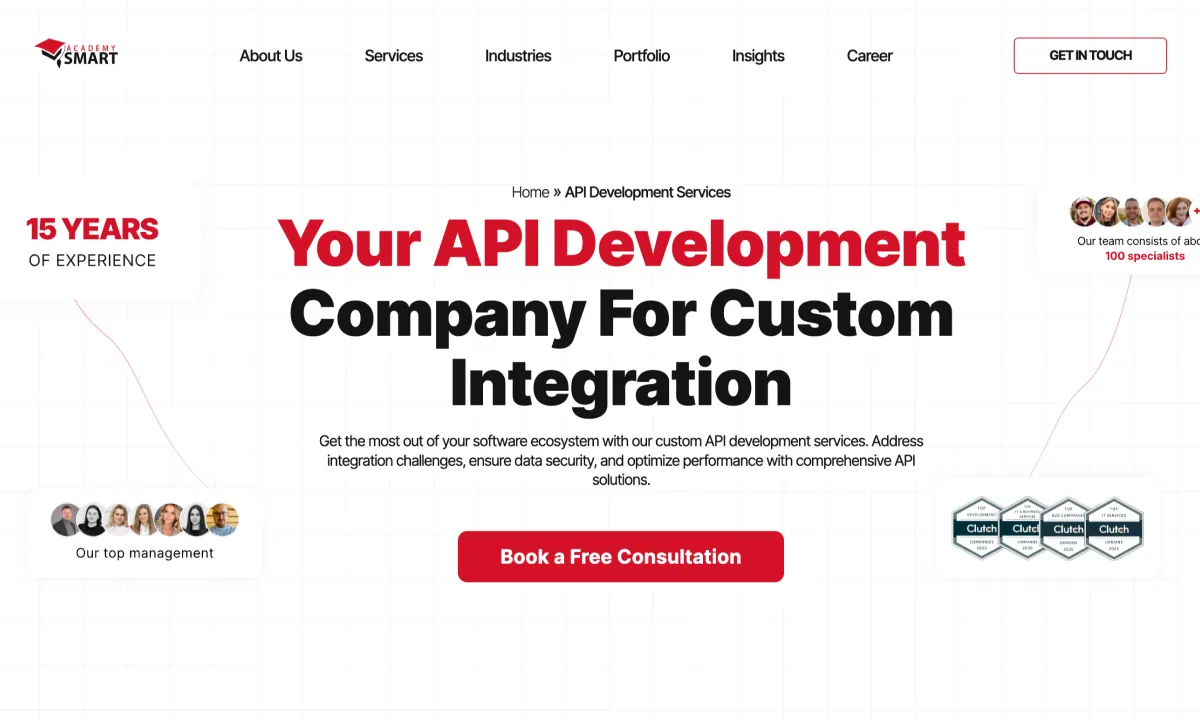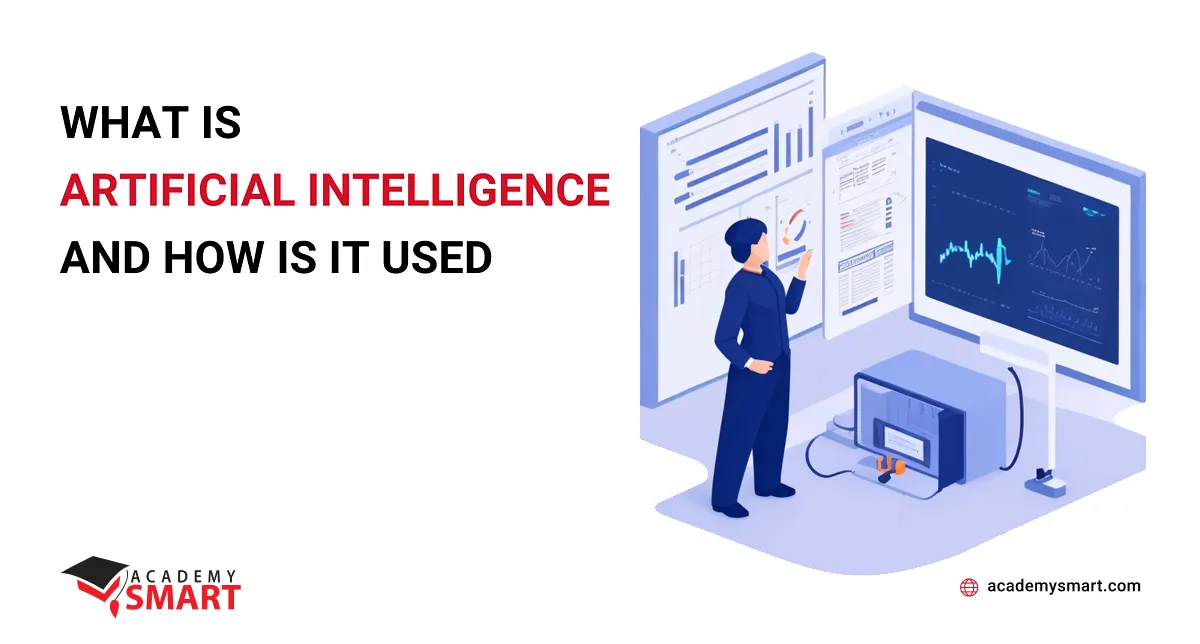
What is artificial intelligence and how is it used
Contents
Artificial intelligence is an advanced information technology with great potential, already applied in various industries and business models today. Breakthroughs in the field of AI development in recent years are causing a sincere interest in the further growth of this area of computer science and the prospects for its application, as well as concerns about its impact on changing economic life and the future interaction of people and machines. So, this article is intended to consider the issue on its merits, to answer the question “What is an AI?” and to show examples of how to utilize it to make profitably.
What is an AI
Artificial intelligence (AI) is a branch of computer science focused on creating machines capable of performing tasks that require human-like intelligence. But what does AI mean exactly? In strict terms, AI is a complex software program that can learn, adapt, and make decisions. AI systems replicate human cognitive functions such as understanding speech, playing games, and recognizing patterns. They achieve this by processing vast amounts of data and learning from it.
Now, what is AI technology basis? Its power stems from technologies like deep learning and natural language processing. These technologies enable computers to comprehend human language and learn complex tasks from examples. As we continue to advance AI, its impact on various industries grows, enhancing sectors ranging from healthcare to transportation.
Artificial Intelligence history
AI history began in the 1950s with Alan Turing’s introduction of the Turing Test for machine intelligence. The explanation of the term “what is artificial intelligence” was coined, and the Dartmouth Summer Research Project became its birthplace. Early programs like Logic Theorist and General Problem Solver showcased reasoning abilities.
In the 1960s, Stanford’s first AI Lab laid the foundation for progress. Expert systems DENDRAL and MYCIN demonstrated AI’s potential in specific domains. The first dedicated AI programming language, Prolog, appeared in the 1970s. Over the next 30 years, applied machine-learning methods were explored but hampered by limited computing power and high implementation costs.
By the 1990s, technical advancements enabled practical AI applications. Logistics planning during the Gulf War exemplified AI’s usefulness. IBM’s Deep Blue defeating chess champion Garry Kasparov marked a gaming milestone. The 2000s saw attention on self-driving cars and IBM’s Watson triumphing on Jeopardy! Challenge. Siri introduced AI-powered virtual assistants.
In the 2010s, deep learning and neural networks transformed AI. Google’s AlphaGo conquered Go, and self-driving cars passed driving tests. Models like GPT-3 and BERT advanced language processing and redefined human-computer interaction today, marking AI’s ongoing evolution.
AI in today’s world
Today, artificial intelligence is an integral part of various applications, ranging from simple recommendation algorithms to advanced chatbots like Alexa and Siri. AI’s capabilities extend to weather and financial predictions, process optimization, and reducing cognitive tasks such as tax accounting. It’s utilized in game playing, autonomous vehicles, language processing, and more. OpenAI’s ChatGPT, introduced in 2022, quickly gained popularity, engaging millions of users monthly in 2023, responding creatively to diverse topics and showcasing AI’s versatility.
What is AI technology demand now? AI usage spans various areas. In healthcare, personalized medicine and health assistants aid patient well-being. The field of retail benefits from AI-driven shopping and improved stock management. Banking enhances precision, fraud detection, and data management. Manufacturing employs AI to forecast production demands through data analysis.
Executing AI involves complex technical infrastructure and computational costs, but stimulating the technological progress of the digital informational environment. Its integration transforms operations, making AI essential to modern economic life. Check out the live examples of AI-powered apps created by our programmers in the short presentation below.
Types of AI
A more complete understanding of what an AI is and what types of tasks they are capable of performing can be obtained through the prism of a variety of kinds of artificial intelligence. There are several authoritative and widely recognized classifications of AI types, each focusing on different aspects of AI capabilities and functionality. Let’s explore some of them below.
Top-level classification types
First, it’s common to categorize AI into two main types: Narrow AI and General AI.
Narrow AI, also known as Weak AI, refers to AI solutions designed for specific tasks and excel in those tasks. Examples include voice assistants like Siri or Alexa and specialized systems like self-driving cars or recommendation algorithms in platforms like Netflix. These systems are highly skilled within their defined domains but lack broader human-like cognitive abilities.
On the other hand, General AI, also called Strong AI, is a hypothetical form of AI that would possess human-like cognitive capabilities and handle a wide array of tasks, similar to human intelligence. This type of AI is often depicted in science fiction movies and books, where machines can solve novel problems and exhibit human-level understanding and reasoning. However, the development of General AI is still a complex challenge and hasn’t been achieved yet.
Types based on functionality
Another two primary types are Reactive and Reactive with Learning.
Reactive AI operates based on predefined rules and algorithms. It optimizes outputs based on specific inputs. A classic example is chess-playing AI, like IBM’s Deep Blue, which calculates the best moves to win the game. However, reactive AI is relatively static and cannot learn or adapt to new situations. It produces consistent outputs for identical inputs, making it suitable for tasks with clear rules and limited variability.
Reactive AI with Learning, on the other hand, goes beyond predefined rules. It can learn from data improving its performance over time. This type of AI, like Google’s AlphaGo, uses neural networks to evaluate ongoing developments in a game, making it more adaptable and capable of handling complex scenarios. Reactive AI with Learning can refine its strategies and decision-making based on experiences.
Types based on learning approach
Supervised, Unsupervised, and Reinforcement learning methods shape how AI systems acquire knowledge and skills to perform various tasks.
Supervised Learning involves training AI using labeled data. It’s like teaching a model with examples that have known inputs and desired outputs. The AI learns to make predictions or decisions based on the provided patterns.
Unsupervised Learning is about finding patterns in unlabeled data. The AI identifies inherent structures or relationships within the data without being explicitly told what to look for. It’s like exploring a dataset to discover hidden insights or clusters.
Reinforcement Learning is like how we learn by trial and error. The AI interacts with an environment and learns from its actions and outcomes. It receives feedback through rewards or penalties, guiding it to improve its decision-making over time.
Types based on techniques
Another way to understand artificial intelligence and what pool of tasks and problem-solving methods it can apply is to look at its foundation’s underlying techniques and methodologies.
Symbolic AI relies on explicit rules and representations to process information. It’s like following predefined instructions or guidelines to arrive at conclusions. This approach is particularly suitable for tasks that require logical reasoning and structured knowledge.
On the other hand, Connectionist AI, also known as subsymbolic AI or neural network-based AI, is inspired by the brain’s structure. It uses interconnected nodes like neurons to learn and process information. This approach is well-suited for tasks that involve recognizing patterns, such as image and speech recognition.
Types based on application
The following classification groups AI solutions based on their primary applications or domains.
Expert systems are developed to solve specific problems in a particular domain. They replicate the decision-making processes of human experts by utilizing rules and knowledge bases. Expert systems are helpful for tasks that require complex reasoning within a defined area of expertise.
Natural language processing (NLP) involves AI’s ability to understand, interpret, and generate human language. It enables machines to comprehend and respond to text or speech input. NLP is used in various applications, including chatbots, language translation, sentiment analysis, and text summarization.
Computer vision focuses on enabling machines to interpret and process visual information from the world, similar to how humans perceive images and videos. AI software in this category can analyze images, recognize objects, detect patterns, and even understand facial expressions. Applications range from self-driving cars to medical imaging.
Robotics integrates AI into physical machines, allowing them to interact with and manipulate their environment. These AI systems enable robots to perform manufacturing, surgery, exploration, and household chores. Robotics involves a blend of sensing, decision-making, and mechanical actions.
Types based on complexity
The following categories illustrate the progression of AI capabilities from basic rule-based applications to more sophisticated AI that can learn from experiences, understand human-like behavior, and even achieve self-awareness in the future.
Simple reactive systems are the foundational level of AI. These apps operate based on predefined rules and respond directly to specific inputs without memory or learning capabilities. They follow a fixed set of instructions to make decisions and are well-suited for specialized tasks with clear rules and restricted variations. Examples of simple reactive systems include chess-playing programs that evaluate each move based on immediate possibilities without considering past games or evolving strategies.
Complex reactive systems build upon simple reactive systems by incorporating more intricate sets of rules and a more comprehensive range of inputs. They can handle more complex situations and exhibit behavior that appears more sophisticated. However, they still lack memory and learning abilities, meaning they respond based on immediate stimuli rather than accumulated experience. Examples include advanced autonomous vehicles that navigate through complex traffic scenarios using predefined rules for different situations.
Limited memory systems take a step further by incorporating memory and learning capabilities. These AI apps can adapt based on past experiences, making decisions informed by historical data. While their memory is finite and shorter-term, they can use previous interactions to improve decision-making in real-time situations. Autonomous vehicles that learn from various driving instances and adapt to new challenges are an example of limited memory systems.
Theory of mind systems represents a theoretical concept where AI would understand other entities’ thoughts, emotions, and intentions, similar to how humans perceive and interpret each other’s behaviors. This level of AI would involve processing complex psychological concepts and using this understanding to interact more deeply with humans and other AI software. However, achieving the theory of mind AI is a difficult challenge, as it requires replicating human-like understanding and emotional processing in machines.
Types based on autonomy
These types reflect the varying levels of human-AI collaboration and the degree of AI’s ability to function independently.
Assisted AI refers to applications that support and enhance human activities and tasks. These AI systems provide recommendations, insights, or suggestions to help humans in decision-making and problem-solving. The primary goal of assisted AI is to increase efficiency and accuracy in tasks that humans perform by leveraging AI’s ability to analyze data and provide relevant information. Examples of assisted AI include virtual assistants that help users with scheduling, reminders, and information retrieval.
Augmented AI involves a collaborative interaction between humans and AI systems. In this type of AI, the strengths and capabilities of both humans and AI are combined to achieve better results than either could achieve alone. Augmented AI apps empower humans by providing tools and insights that enhance their abilities. They emphasize the partnership between humans and AI, allowing them to work together in synergy. For instance, in medical diagnosis, AI software can analyze medical images and provide recommendations to doctors, aiding them in making more accurate diagnoses.
Autonomous AI represents systems that operate independently with minimal human intervention. They can make decisions and take actions on their own based on predefined rules, learned patterns, or real-time data analysis. Autonomous AI is developed to perform tasks without requiring continuous human guidance. Examples of autonomous AI include self-driving cars that navigate and make decisions while on the road and industrial robots that perform manufacturing tasks without constant oversight.
These are just a few examples of how AI can be classified. Researchers, experts, and organizations may have other classifications based on their specific focus, goals, and answers to the question, “What is artificial intelligence?”. The field is dynamic and continually evolving, so new classifications may emerge as AI technology advances.
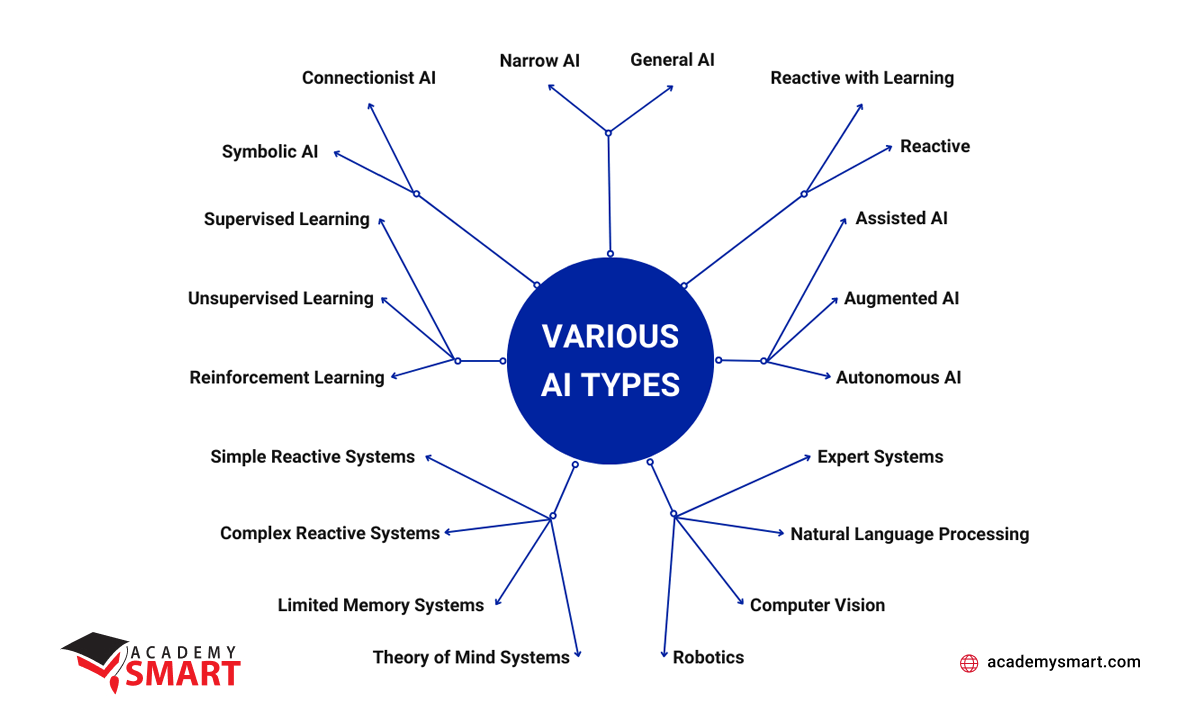
Various AI types
Artificial Intelligence: examples
Well, what are artificial intelligence examples in business practice? The following samples showcase how AI has been implemented into various aspects of enterprise operations. By the way, most modern AI solutions are available for API integration into any business information system.
- IBM Watson
IBM Watson is an AI platform that has been utilized across various industries for complex data analysis and decision-making. For instance, in healthcare, it has assisted doctors in diagnosing diseases and suggesting treatment options. It has also found applications in financial services for risk assessment and fraud detection. - Amazon Web Services (AWS) AI Service
Amazon’s AI services provide a suite of tools that allow businesses to integrate AI capabilities into their applications. It includes services like Amazon Rekognition for image and video analysis, Amazon Comprehend for natural language processing, and Amazon Polly for text-to-speech conversion. Companies use these services to enhance their products and services with AI-powered features. - Salesforce Einstein
Salesforce Einstein is an AI-powered feature within the Salesforce Customer Relationship Management (CRM) platform. It helps businesses make more intelligent decisions by analyzing customer data, predicting outcomes, and automating various tasks. Einstein can provide insights to sales and marketing teams, enabling personalized customer interactions and efficient lead management. - SAP Leonardo
SAP Leonardo is an AI and Internet of Things (IoT) platform by SAP that allows businesses to leverage AI and data-driven insights to improve various processes. It’s used for applications such as predictive maintenance in manufacturing, supply chain optimization, and enhancing customer experiences through AI-driven insights. - Chatbots for customer support
Numerous enterprises have implemented AI-powered chatbots to provide customer support. These applications use natural language processing to understand and respond to client queries. They can handle routine inquiries, assist, and direct customers to appropriate resources, enhancing customer service efficiency. - Autonomous supply chain management
Large enterprises like Walmart and Procter & Gamble are using AI to optimize their supply chain operations. AI algorithms analyze data on demand, inventory levels, transportation, and external factors like weather and geopolitical events. That enables more accurate demand forecasting, efficient inventory management, and streamlined logistics. - Financial trading and investment
AI has been successfully employed in the financial industry for algorithmic trading and investment management. Hedge funds and asset management companies use AI algorithms to analyze market data, identify patterns, and execute trades at high speeds, making data-driven investment decisions.
Of course, super-popular, generative neural networks like ChatGPT and Midjourney are now on everyone’s lips. In many ways, interaction with them forms the public’s perception of what an AI is.
How does an artificial intelligence work
As you know, different AI types have unique functioning specifics. Therefore, we propose considering “how does AI work” in some generalized examples. Suppose we have an AI model with relevant algorithms for a specific task. Here’s a simplified explanation of how an artificial intelligence works in this case:
- Data Input
Provide the AI model with input data. It could be text, images, numbers, or other relevant data forms. - Feature Extraction
The AI model identifies relevant patterns and features within the input data. This process is crucial for the model to understand the underlying information. - Algorithm Application
The AI model applies specific algorithms designed for the task. These algorithms process the extracted features to make predictions, classifications, or other desired outcomes. - Learning and Optimization
If the model is based on machine learning, it adjusts its internal parameters based on the provided data and the desired outcome. This optimization process fine-tunes the model for better accuracy. - Prediction/Output
Once the model has learned and optimized its parameters, it generates predictions or outputs based on new input data. For instance, if it’s a language model, it might create text; if it’s an image classifier, it might categorize images. - Evaluation
The predictions or outputs are assessed against the desired outcome or ground truth. This evaluation helps check the effectiveness of the AI model. - Feedback Loop
The model might undergo further optimization depending on the evaluation results. This feedback loop allows the model to improve performance with more data and iterations.
Of course, the model’s accuracy and efficiency significantly depend on the quality of the algorithms, the training data, and the optimization process. Moreover, regular monitoring is necessary to ensure that the AI model’s performance remains consistent, and maintenance is required to update the model, retrain it with new data, or address issues that arise. At last, you need qualified IT staff, in-house, outstaffing, or outsourced, to keep your AI up and running.
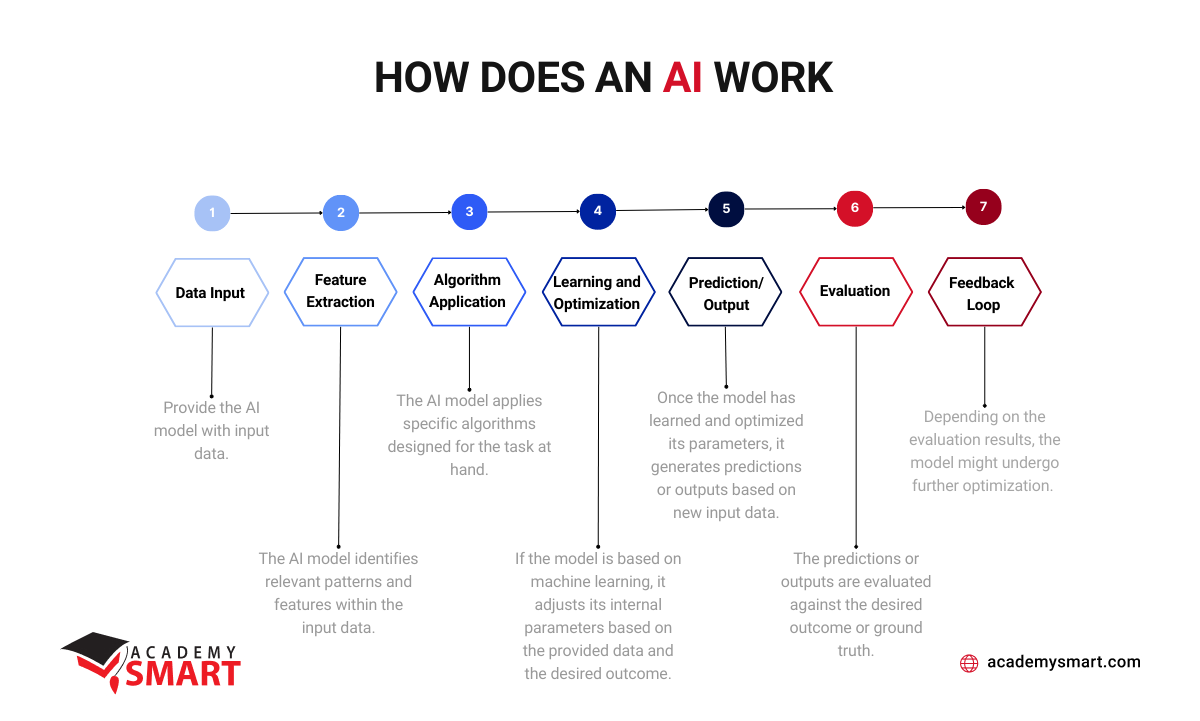
How does an artificial intelligence work
How to use Artificial Intelligence
Artificial Intelligence offers both benefits and limitations in its applications. On the positive side, AI excels at automating repetitive tasks, relieving humans from high-volume, computerized duties while maintaining reliability. It enhances existing products, integrating intelligence into familiar technologies. AI’s progressive learning allows algorithms to acquire skills from data, enabling it to adapt and improve over time.
AI’s analysis capabilities are amplified through deep neural networks, processing vast and intricate data sets that would have been challenging previously. It leads to remarkable accuracy, as seen in applications like voice assistants and medical image recognition. AI capitalizes on data as an asset, with self-learning algorithms extracting valuable insights, giving a competitive edge to those with superior data. Earlier, we’ve described several practical ideas to utilize AI-powered applications for various business purposes.
However, AI has challenges we also have to mention. While it can be efficient at specific tasks, it lacks comprehensive human-like understanding. It requires substantial data for training, making it susceptible to biases present in the data. AI struggles with uncommon scenarios and may misinterpret context. There’s also the ethical concern of job displacement, as AI automates roles that were once human-operated.
Everyday tasks where AI excels include:
- Recommendation systems
AI suggests products, services, or content based on user behavior and preferences. - Natural language processing
AI interprets and generates human language, facilitating chatbots and language translation. - Image and video analysis
AI detects patterns, objects, and sentiments in visual data, aiding in content moderation and medical imaging. - Data analysis
AI processes and analyzes vast datasets to extract insights, making them valuable in research and business decisions. - Virtual assistant
AI-driven assistants like Alexa and Siri respond to voice commands, perform tasks, and provide information. - Fraud detection
AI identifies unusual patterns in financial transactions, helping detect fraudulent activities. - Healthcare diagnostics
AI assists in diagnosing diseases by analyzing medical images and data, improving accuracy. - Autonomous systems
AI powers self-driving cars and drones, enabling automation and decision-making.
AI’s capabilities enhance efficiency, accuracy, and decision-making across various domains. While it has certain limitations, its potential to transform industries and improve processes remains significant. For instance, AI-driven solutions developed by Academy Smart work perfectly for our clients today. You may find their examples on our portfolio page right now.
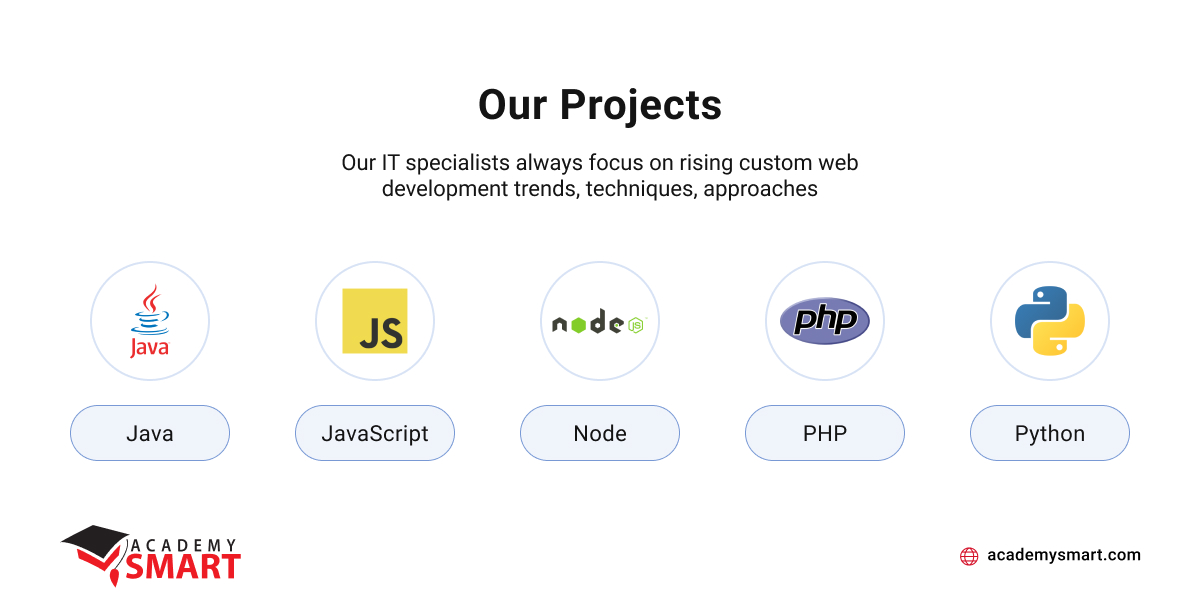
Our portfolio page to meet examples
How Academy SMART can help you
Creating and maintaining AI applications with complex architectures requires a high level of professionalism, a deep knowledge of practical machine learning techniques and programming languages, creativity, and a love of solving non-trivial problems. You may get such specialists by choosing the Academy Smart IT agency as a technical partner.
Our staff will help you develop a turnkey AI-driven app or quickly join your in-house development team, bringing a quality work ethic and substantial expertise. With the help of our recruiting department, you will soon find competent programmers, project managers, and business analysts with various experiences in creating projects based on AI. Our talents may bring your ideas to life. Get in touch for further details.
What is an AI: Frequently Asked Questions
How is Artificial Intelligence used today?
Artificial intelligence is used today in various applications, such as personalized recommendations in streaming services, virtual assistants for tasks and queries, fraud detection in financial transactions, autonomous vehicles for safer transportation, and image recognition in medical diagnostics.
Why is AI so important?
AI is crucial because it enhances efficiency, accuracy, and decision-making across industries, transforming data into insights and automating once time-consuming tasks, enabling innovative solutions to complex problems.
Book a free consultation

Reach out to start talking today!

